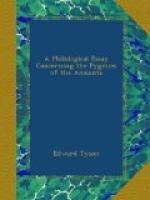[Footnote A: Diodor. Siculi Bibliothec. lib. 2. p.m. 118.]
[Footnote B: Strabo Geograph. lib. 14. p. 451.]
[Footnote C: Lucian lib 1. verae Histor. p.m. 373.]
[Footnote D: Arist. Hist. Animal. lib. 8. cap. 28.]
[Footnote E: A. Gellij. Noctes. Attic. lib. 9. cap. 4.]
[Footnote F: Henr. Stephani de Ctesia Historico antiquissimo disquisitio, ad finem Herodoti.]
But this Story of Ctesias’s speaking Pygmies, seems to be confirm’d by the Account that Nonnosus, the Emperour Justinian’s Ambassador into AEthiopia, gives of his Travels. I will transcribe the Passage, as I find it in Photius,[A] and ’tis as follows:
[Footnote A: Photij. Bibliothec. cod. 3. p.m. 7.]
[Greek: Hoti apo taes pharsan pleonti toi Nonnosoi, epi taen eschataen ton naeson kataentaekoti toion de ti synebae, thauma kai akousai. enetuche gar tisi morphaen men kai idean echousin anthropinaen, brachytatois de to megethos, kai melasi taen chroan. hypo de trichon dedasysmenois dia pantos tou somatos. heiponto de tois andrasi kai gynaikes paraplaesiai kai paidaria eti brachytera, ton par autois andron. gymnoi de aesan hapantes; plaen dermati tini mikroi taen aido periekalypron, hoi probebaekotes homoios andres te kai gynaikes. agrion de ouden eped eiknynto oude anaemeron; alla kai phonaen eichon men anthropinaen, agnoston de pantapasi taen dialekton tois te perioikois hapasi, kai polloi pleon tois peri taen Nonnoson, diezon de ek thalattion ostreion, kai ichthyon, ton apo taes thalassaes eis taen naeson aporrhiptomenon; tharsos de eichon ouden. alla kai horontes tous kath’ haemas anthropous hypeptaesan, hosper haemeis ta meiso ton thaerion.]




